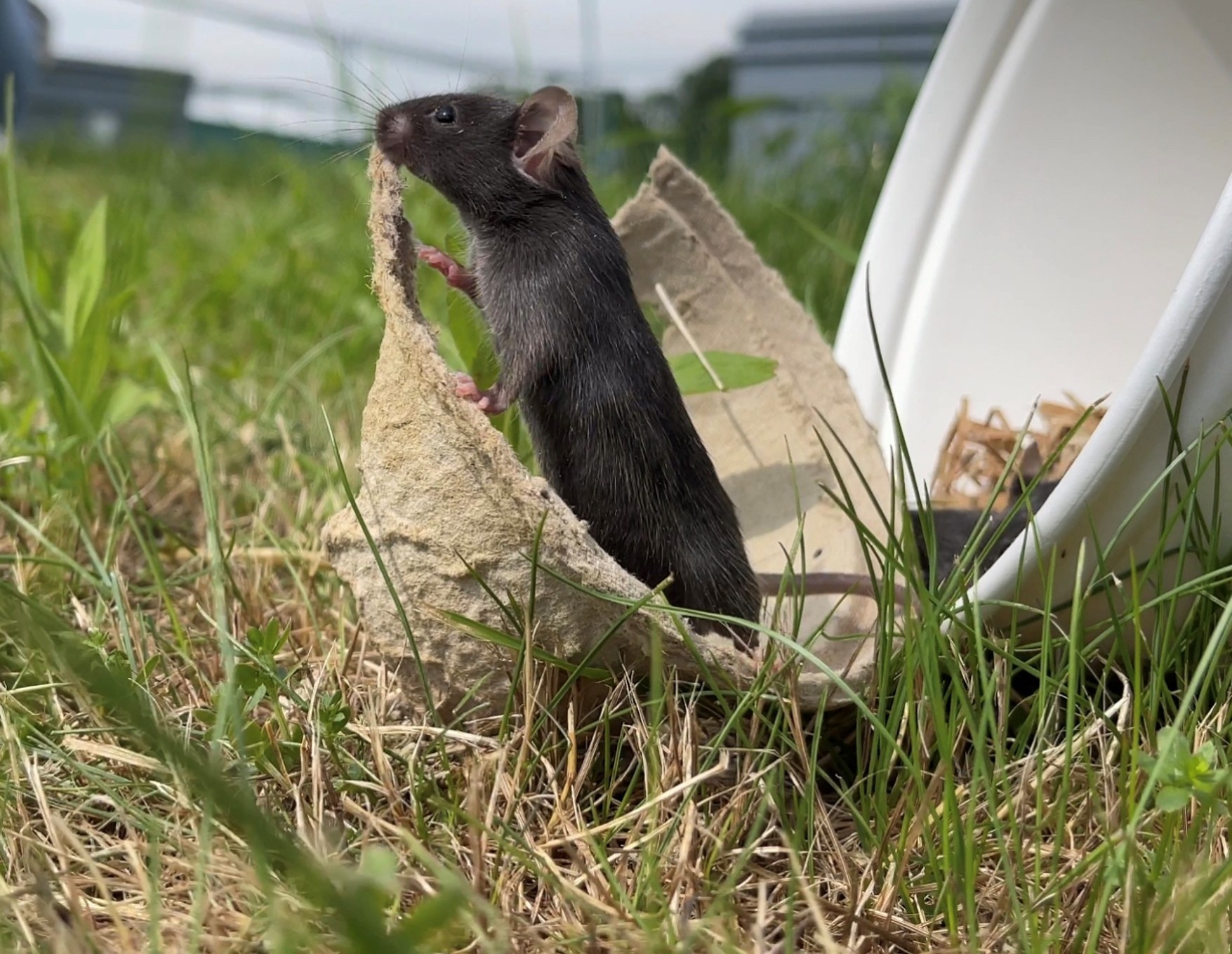It was a pretty neat trick while it lasted. For a long time, the TSA's big full-body scanners required the agent working them to input the gender of the person being scanned, so that the machines could have a better idea of which protrusions and curves were organic and which were contraband. But since it's impossible to divide all the bodies on Earth into two neat, uniform categories, these machines were a big hassle to anyone who didn't conform perfectly with the pink or the blue button. I, being one of those people, shut off my brain and endured invasive groin searches again and again when I flew, until I developed some confidence and knowledge that alleviated a lot of my difficulties. When my groin was flagged, I'd ask, politely, "Do you want to change the gender and try again?" After the second scan, I'd either be let through or, more often, my chest would be flagged but subject to a much simpler and quicker touch around my shoulders.
While refusing to compromise on my belief that I shouldn't have to pay extra for pre-check just to avoid the back of a stranger's hand on my junk, I figured out how to make a flawed system work for me, and it was manageable for a couple of years. But now, thanks to an apparent attempt to fix the system's inherent flaws, I've been confronted by a problem whose causes are much more opaque, even as its effects are all too familiar. TSA knew about the trans dilemma, and over the first half of 2023, they rolled out something advertised as a fix: an outwardly genderless system that used an updated algorithm and "artificial intelligence" to give a more individualized scan to every airport entrant. From a March 2023 article in Condé Nast Traveler:
Fortunately for fliers, the number of passenger pat-downs is shrinking, according to the TSA, thanks to new artificial intelligence-based technology the organization has been rolling out for the past several months. The improvement comes in the form of an updated algorithm used on TSA’s body scanners that’s designed to substantially decrease the amount of false alarms that lead to erroneous pat-downs.
The new algorithm was designed to ease the body scanner process for transgender, nonbinary, and gender nonconforming travelers, who in the past have often had issues with the machines. That’s because previously, the scanners—called Advanced Imaging Technology, in industry jargon—have relied heavily on a gender binary to determine the machine’s results and whether passengers could be hiding contraband. If a security officer misgendered a passenger, the machine would flag them for additional screening, which often meant pat-downs in sensitive areas.
(A quick correction to this press-release journalism: The problem wasn't agents "misgendering" passengers. I always got correctly gendered, but the problem was that my body didn't conform to the machine's idea of either of the two types of bodies it was programmed to accept.)
In the past year, I've flown on three round-trips: a summer wedding, Thanksgiving, and Christmas, all between JFK and Detroit. On two of those six flights, I made it through the scanner completely clean and untouched—how life should be for girls without guns stuffed in their pants. But on the other four I was flagged and, without my usual recourse, forced to submit to a patdown. The first time, heading home in the summer, I tried my old line, and the agent told me, not unkindly, "It actually doesn't work like that anymore." Fair enough. I went one for two again in November, caught hopelessly flat-footed when the little red box appeared on the screen. Over the holiday season, however, I got nailed twice, and I took a tone with the agents that was both curious and exasperated. In doing so, I learned that nobody seems to know how this stuff works.
After I got flagged at JFK, I told the agent, "I thought this wasn't supposed to happen anymore."
"I thought so too," she shrugged. I appreciated the candor, and the fact that there was awareness on both sides of this search gave me some hope that there might be a fix for the problem. While in Michigan, I sent an online message to TSA customer service looking for tips. Here's what I wrote:
Hi, I'm a trans woman who flies several times a year, and as I'm sure you can imagine, getting through screening while inevitably being searched in a sensitive area has been tough. With the old gendered system, the cause was obvious. But even with the algorithm update, three of the last five times I've flown, I've still had to undergo an inconvenient groin search. This has happened both at JFK and DTW, and when I said to the woman who searched me most recently, I thought you guys had fixed this, all she could say was, I thought so too. Do you have any sense of why this continues to happen to me, or how I can avoid it? Thanks.
The response was reasonably prompt but totally boilerplate:
We recognize the concerns that some members of the transgender community may have with certain security screening procedures at the Nation’s security checkpoints. Our policies and procedures ensure that all travelers are treated with respect and courtesy, and emphasize that screening must be conducted without regard to a person’s race, color, sex, gender identity, national origin, religion, or disability.
For more detailed information about the screening process, we encourage you to review our tips for transgender passengers at www.tsa.gov/transgender-passengers.
The link didn't even have the most up-to-date information. "When you enter the imaging portal," it still reads, "the TSA officer will press a button designating your gender as male or female based on the TSA officer’s assessment of how you present." What I wanted was someone who understood the algorithm to give me a heads-up about what I could do to be more friendly to it—clothing, tucking, anything else about my appearance. But what I got was less than useless, and when I flew out of Detroit, I was more frustrated than ever.
"I thought this wasn't supposed to happen anymore," I said, again, looking for some sympathy.
"What do you mean, 'It's not supposed to happen?'" the agent replied, a little annoyed.
I tried to throw her a line. "For trans women, I thought they changed the algorithm."
I figured she must have had this experience before—a point in my favor is usually that the agents themselves don't like the search process either—but she gave no indication that she had any clue what I meant. "Well, it buzzed," she said. The search itself ended up being one of the less physically uncomfortable I've had, but at this point I couldn't help but get just a little bit snippy. "Any areas sensitive to touch?" she asked. "Umm ... all of them?" I had to reply.
I'm very protective of my body. I don't live numb as a coping mechanism like I did when I was younger, but my physical language still unconsciously broadcasts concealment, shyness, retreat, enough that people close to me, on occasion, have made a point of saying that I can let go and relax when I'm around them. Even with those I trust intimately, however, my body can automatically get skittish. I'll startle—embarrassingly, a little pathetically—at innocuous surprise touches. I need to see their touch and know it's coming, because my default setting is an unwelcoming one.
TSA agents, despite working in an environment where everyone is at least a little bit anxious, have noticed my unease. The one in Chicago who pointed out—kind of sweetly—that I was shaking was the one who inspired me to attempt strategies to actually skip this awful part of flying. But of course, I have so little power in these situations. Once the search is inevitable, my only remaining autonomy is whether to make them drag it out or try to speed them along as much as possible. I always choose the latter. I want them to hurry up. I want that moment where they make contact at my absolute least favorite spot, while I'm furiously suppressing every natural instinct to yell or run or hit them, to be over as fast as it can.
If the decisions of whether or not to search me were made by the agents themselves, I could maybe begin to accept that. In this scenario, where a person who is tasked with doing everything they can to keep threats off planes sees some anomaly, and thinks, Better safe than sorry, I can at least understand the cause-and-effect. Plus, if the person in question is misusing that power to single me out, I know exactly who my enemy is.
But my enemy now is the black box of an algorithm, and the agents I talk to are simply paid to follow its orders. Back when the algorithm just straight-up did not allow that someone like me could exist, even then I understood the problem and could scientific-method some solutions. Now, though, the obstacle is invisible, unpredictable, and worst of all, presented as an improvement. Until my little blogger brain hits on a new idea, or until this tech actually becomes as reliable as it claims to be, I'll keep getting unwanted touches, and not a single person in the entire airport will be able to tell me why in more detail than, "Well, it buzzed."






